
Alabama’s Brian Robinson was the most impressive physical specimen among running backs at the Senior Bowl:
The Speed Score zealots would have you believe that Robinson is a good athlete. But that couldn’t be farther from the truth. The only measure by which he is even an above-average athlete is his 10-yard split. It’s the most technique-dependent portion of the 40-yard dash. And it’s not as indicative of a player’s actual full speed as their flying 20-time is.
Robinson has below-average top speed, awful agility, and terrible burst. He’s 220-pounds and was able to explode out of a three-point stance at the Combine. So box checked, I guess.
Based on the above measurables, the following historical prospects are Robinson’s most similar from a purely physical standpoint:
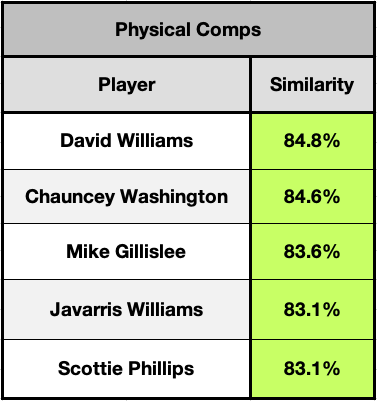
Surely the Speed Score zealots were also big fans of David Williams, Chauncey Washington, Mike Gillislee, and Javarris Williams. They were all 220-pound running backs who ran sub-4.55 and went on to dominate in the NFL.
Production Profile
Brian Robinson‘s flamethrower performance at the Combine was almost as impressive as his strong resumé of collegiate production:
Robinson was at Alabama long enough to play in games started by all four of Jalen Hurts, Tua Tagovailoa, Mac Jones, and Bryce Young. Given that he didn’t take an actual redshirt year, the only reason he posted the career-best 48th-percentile Dominator Rating he had as a fifth-year senior in 2021 was the extra year of eligibility granted after the COVID-affected 2020 season.
The kicker there is that Alabama’s 2020 season wasn’t really affected that much since they still played 13 games. It’s not as if Robinson was robbed of a senior season and got to come back. He had a completely un-noteworthy traditional four-year career. This before being gifted an extra season where he posted marginal market share numbers as a 22-year old super senior. Robinson played on good teams with lots of talented players on them. But he himself was just never a quality college football player. At least until he was so old that the normal eligibility he had was completely used up.
Given the seasonal Dominator Ratings he posted and the quality of teams on which he played, his closest production comps are the following historical prospects:
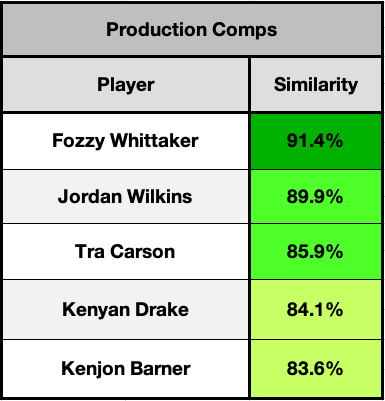
Rushing Efficiency
I wrote a full breakdown of Brian Robinson‘s rushing efficiency profile that can be found here. The following is a quick overview:
Box count data is not available for Robinson’s freshman season. Makes sense considering that it happened back in the stone ages. But in each of his other three years as a part-time player for the Tide, he posted negative team-relative efficiency numbers. This while seeing lighter box counts than the other backs on the team. In those seasons, his Box-Adjusted Efficiency Rating never even reached the 5th-percentile.
In his only season as a starter, he did post positive team-relative numbers across the board in the YPC+, Chunk Rate+, BAE Rating, and Relative Success Rate categories. The only one of those numbers that was truly impressive, however, was his RSR:
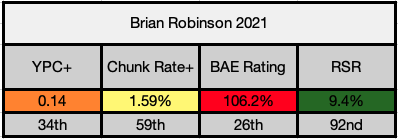
A quality RSR is certainly a good thing. It indicates that a player is gaining a requisite amount of yards at a greater rate than his teammates are given the down-and-distance situations he is carrying the ball in. It’s a measure of consistency in navigating the line of scrimmage and producing positive outcomes. Robinson was elite there in 2021. Outside of breaking tackles, it’s also the only quality element of his overall efficiency profile.
Rushing Efficiency Score
Brian Robinson was not producing more per-touch than over Bama backs were. He failed to do that while not seeing difficult relative box counts. And he was not creating breakaway runs in the open field. The backs he played with in Tuscaloosa were a very talented group. But that doesn’t preclude Robinson from having to prove himself relative to those guys. Here is his composite Rushing Efficiency Score listed next to the composite scores of every running back drafted out of Alabama since 2007:
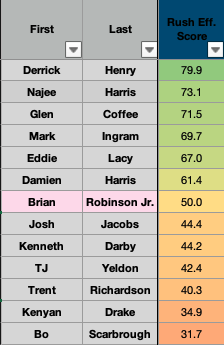
As his score indicates, Robinson is probably an average runner of the football. As his efficiency metrics indicate, his value probably comes in consistently making the right reads and not producing negative plays on the ground. But he doesn’t have the juice to do much else.
Given his physical profile in combination with the above metrics, the most similar historical prospects to Robinson from a “pure runner” perspective are:
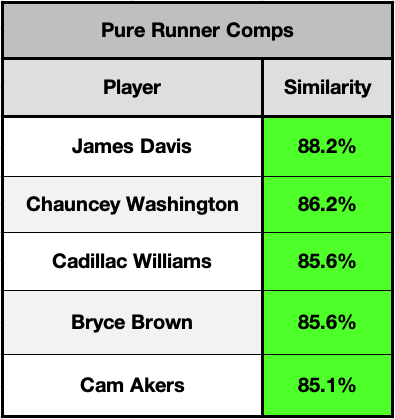
Receiving Chops
Brian Robinson probably does provide some value as an option in the passing game:
More so than volume, I like to see my running back prospects see dynamic deployment and quality efficiency as pass-catchers. Robinson checks those boxes.
He wasn’t quite Kenneth Gainwell out there. But Robinson was moved around the formation and targeted further downfield than most running back prospects are. On those relatively advanced targets, he caught a high percentage of his passes and was efficient.
Given the above metrics, here are the historical prospects whose receiving profiles most closely resemble Robinson’s:
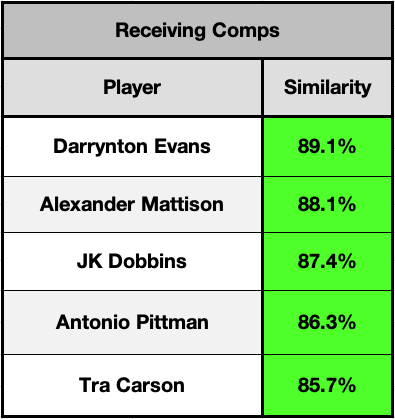
Robinson is not likely to be a high-volume, versatile receiving threat in the NFL. But he won’t need to be pulled off the field in passing situations.
Overall Profile
Overall, Brian Robinson is a player who checks the minimum boxes of size and pass-catching ability that allow him to be deployed on all three downs. He’s also a decent runner. But that’s where the positives end with his profile.
He doesn’t have the dynamism to make things happen in the open field. He doesn’t add much value beyond not screwing things up when the ball is in his hands. And he never had a sizable role until he’d spent more time in college than most players are allowed to. Despite what the fake news media would have you believe, he’s also not athletic.
The historical prospects whose complete profiles are most like Robinson’s are the following:
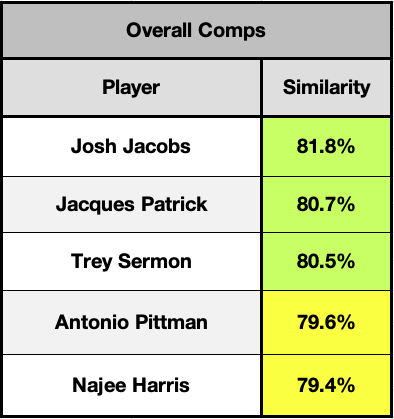
Josh Jacobs and Najee Harris are recent Alabama draftees who’ve been productive pros. NFL teams are likely to be interested in Robinson as well. He won’t be a first round pick. But he wore a crimson helmet with a cream-colored number on it. So he’ll go higher than his overall profile would suggest he should.
At that point, the draft capital zealots will fuse with the Speed Score zealots and tell you that a 220-pound third-round pick who ran a 4.50 and caught 35 passes in his most productive college season is a lock for quality fantasy production. The microscope reveals that Robinson probably just isn’t that good. He’s probably a Javorius Allen or T.J. Yeldon-type guy at the next level. But even those guys were better prospects than he is.






